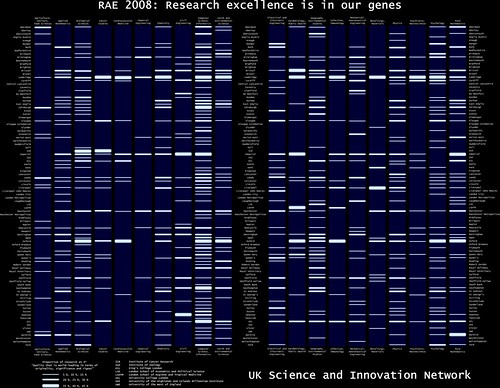27th May 2011 Toronto, Canada
Excellence in UK research
This is John Preece guestblogging about another question we at SIN get asked quite often – excellence in UK research. British universities consistently undertake world-class science, receiving over 12 % of all citations to published papers and 10 % of internationally-recognised prizes each year with just 1 % of the world’s population. This assiduous output is reviewed every four years or so in a process called the Research Assessment Exercise (RAE), the most recent of which was in 2008.
Each RAE produces a large amount of data (every research activity at every institution is reviewed), so I pulled out some of the more relevant results from 2008 in an effort to visualise where the UK’s strengths are in science and technology subjects. Below (click to enlarge or check it out on Scribd) is a diagram showing research areas as vertical “DNA samples” and institutions as horizontal “markers”. The width of each “marker” shows the proportion of research carried out at the highest “4*” level (“Quality that is world-leading in terms of originality, significance and rigour”).
One final example of world-leading UK research: Modern DNA profiling was developed at the University of Leicester by Alec Jeffreys in the mid-1980s, and refined by Peter Gill at the Forensic Science Service. This work revolutionised criminal investigation, identifying suspects with unprecedented accuracy and exonerating hundreds of wrongly-convicted people.

1 comment on “Excellence in UK research”
Comments are closed.